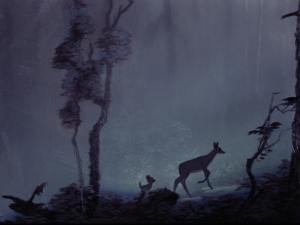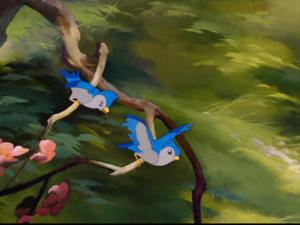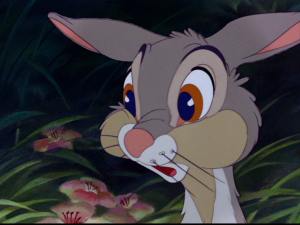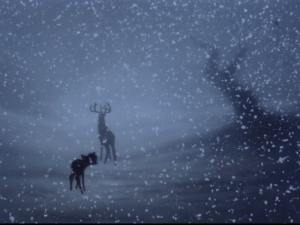Bambi (David Hand, 1942)
Bambi was the last great Disney cartoon. It was the last in his amazing run of features between 1937 and 1942 (following Snow White, Pinocchio, Fantasia, and Dumbo), and was in many ways the climax of that sequence. After Bambi the studio would never quite be the same again: a divisive strike, financial difficulties, and World War II would see Disney give up on true feature film production for the rest of the forties. For all their virtues, the features he would make later (starting with Cinderella in 1950) never reached the heights of these first five features. Bambi, with its cute baby animals and impeccable animation, is also probably the film that epitomises the common perception of Disney films.
It is also the most perfectly rounded of Disney’s features: it has a deceptive simplicity to it, driven by the changing seasons and a story that comes full circle as it moves from one generation to the next. The early sequences show the excitement of forest creatures at the birth of the “young prince,” Bambi. We see Bambi’s struggle to walk, his first words, and his developing friendship with the other woodland creatures, particularly the painfully cute bunny Thumper. The childhood sequences climax with the famously traumatic scene of Bambi losing his mother, and the film moves onto Bambi’s struggles as a young adult. He fights to protect his mate, escapes a forest fire, and in the concluding sequence fathers his own offspring. The film is an idealised account of natural cycles and woodland life: with the exception of the encounter with the rival male deer, all drama comes from disruptions to the natural order caused by man’s intrusion into the forest.
This material makes Bambi possibly the most self-consciously “artistic” of the narrative Disney films – only the non-narrative Fantasia is more self-consciously styled as a work of art. Disney at this time envisaged that his movies would split into two tiers: Bambi would be an example of the upper tier, while the simple, unpretetentious and relatively cheaply produced Dumbo was an example of the second tier. Bambi was therefore produced over an extended period from 1937 to 1942, in order to avoid the need for second-string animators to work on the film. It is therefore almost a show reel of the best that the Disney studio could produce at the height of its powers. The images have a painterly quality, with long, loving shots of the forest, often rendered with the studio’s multi-plane camera to give them a greater depth and sense of immersion. The backgrounds make bold use of colour to reflect both the passage of seasons and emotional moods. Even in its most lighthearted comic moments it is a display of virtuoso animation, since much of the humour derives from exaggerated depiction of the animal’s movements, such as Bambi’s attempts to walk, or the sequence in which he tries to stand on ice while Thumper skates around him. The animation in the film was led by Milt Kahl and Frank Thomas, at this time considered by Disney to be his best animators, and is of an impeccable standard throughout.
All this artistry would be wasted if the film were not telling a story that could involve the audience. In terms of character, the heart of the film is its first forty minutes, involving the young Bambi and Thumper (I suspect many who saw the film as children barely remember anything that happens after the death of Bambi’s mother). These sequences – full of large-eyed cute animals speaking in babyish voices – would be pure kitsch in the hands of lesser artists. I’ve always loved cartoons in the Warner Bros. / Tex Avery tradition, which rebel against the kind of cute animals seen here: Tex Avery even had his characters beat up fuzzy animals in the Bambi mold (for a brief but spot-on discussion of this by Jaime Weinman, click here). I can therefore understand the occasional unwillingness of adults to revisit the animal characters of Bambi: Certainly it’s difficult to watch Thumper’s scenes without being haunted by the dozens of overly-saccharine cute supporting characters that would clutter the margins of many subsequent Disney films. Yet in Bambi these characters work. It’s partly the sheer expressiveness and quality of the animation, but there’s also a sincerity to these animals that there isn’t in many of the later features, where the reliance on cuteness became much more formulaic. The appeal of the underlying vocal performances also helps: the making-of documentary on the DVD talks of how the animators chose as the voice for Thumper a boy who the casting director wanted to discard, and incorporated his pauses, uncertainty, and eccentric speech patterns into Thumper’s speech. Certainly there’s a natural charm to Thumper’s voice that gives the animation a strong and genuine starting point.
The use of dialogue to shape Thumper’s character is unusual, however: for the most part, dialogue is minimised. The other characters, including Bambi, are defined much more by their movements. The minimal reliance on dialogue also strengthens the film’s emphasis on the harmony and beauty of the natural world. Unlike many of the subsequent Disney films, Bambi realises that to make its animals too human will render them mundane. (Indeed, the film’s worst sequence is the sequence in which the animals are “twitterpated:” the anthropomorphised lust of Bambi, Thumper and Flower simultaneously diminishes the characters and coarsens the film’s tone). Like all the early Disney features, there are few sound effects, so for the most part the soundtrack is driven by the musical score composed by Frank Churchill and Edward Plumb. Bambi recalls Fantasia in the way it seeks a union of music and animation, in this case to create a kind of symphony of nature. One of the film’s best sequences is the song “April Shower,” which is purely about how the forest animals react to the rain (in a modern Disney film, it would be a “want song” for Bambi: “I Just Want My Dad,” perhaps). Being sung by a non-diegetic choir (ie not by the characters), the song doesn’t disrupt the reality of what we are watching, but it also serves as all the soundtrack we need, with musical notes standing in for the opening raindrops, and cymbal clashes for lightning. When a film is constructed this way, the absence of music becomes especially powerful. Such a silence is used to great effect after the death of Bambi’s mother to highlight the appearance of the Great Prince of the Forest, which is marked not by a musical “sting,” but instead by the disappearance of the score.
The death of Bambi’s mother is sometimes cited as one of the most emotionally charged scenes in the Disney canon: the flipside is that it’s also seen as the most manipulative. The length of time Bambi is left to flounder in the snow is probably overkill, but once the Great Prince appears I find the scene very powerful. Over the aforementioned silence there is a quick zoom onto the Prince’s face, a cinematic punctuation of the importance of the moment, before he tells Bambi that his mother can’t be with him anymore. The animation in the reaction shot of Bambi is impressively understated: his whole body is frozen for a long moment, and then his eyes close and his head drops. Bambi was weeping just before he met the Great Prince, but is now rendered silent and immobile. “Come, my son,” says the Great Prince, and leads Bambi away into the falling snow. After the broadness of much of the action elsewhere, this scene communicates the magnitude of Bambi’s loss through its stillness, and the almost monochromatic colour scheme. It’s a very strong moment for the character. In The Lion King, most of the running time was spent with the young lion Simba coming to terms with his grief and his resulting responsibilities. That was perfectly valid in the context of that film, but Bambi makes a very similar point with a single shot: Bambi starts to follow his father, hesitates and looks backward to where he has been, lowers his head, and then carries on.
Another example of the boldness of Disney’s story telling is the transition that immediately follows. After fading out on the stark colours of the snow, the film fades quickly back in to a springtime musical number and a blaze of bright colours. It’s one of a number of challenging transitions in the film, with a similar moment occurring when Bambi’s frolic with Faline is interrupted by a rival male. The use of bold highlights in the fight that ensues is probably the most extreme exaggeration of colour for dramatic effect that occurs in a Disney film. However, the strong delineation of individual sequences for dramatic effect never threatens the unity of the film as a whole. One thing that distinguishes the first five Disney features is how each had a distinct focus and consequent style. Snow White is the magical children’s fairy-tale; Pinocchio a darker morality play in the Grimm tradition; Fantasia a demonstration of animation as high art; Dumbo a lighthearted circus cartoon; and Bambi a hymn to nature. While there is a consistent house style across these films, each confidently bends that house style to different ends. The modern Disney films can match Bambi for its depiction of the natural world for a sequence or two (think of the opening of The Lion King, or the Firebird suite sequence in Fantasia 2000). Yet without the strong influence of Walt Disney at the helm, they try to please everybody and thus dilute their impact. How can The Lion King compete with the simple beauty of a film such as Bambi if it has to find a place for fart gags? No Disney film since Bambi has matched its cohesion of tone and sureness of purpose.



